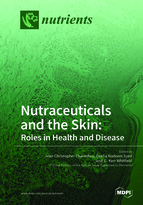Nutraceuticals and the Skin: Roles in Health and Disease
A special issue of Nutrients (ISSN 2072-6643).
Deadline for manuscript submissions: closed (31 December 2017) | Viewed by 116596
Special Issue Editors
Interests: skin health and diseases; carcinogenesis; inflammation; dermatology; psoriasis; atopic dermatitis; bioactive natural products; antioxidants; polyphenols; flavonoids; tissue engineering; signaling pathways; pharmacology
Special Issues, Collections and Topics in MDPI journals
Interests: UV radiation-skin; melanoma-BRAF-inhibitor resistance mechanisms; natural compounds-cancer
Interests: Vitamin D receptor; Vitamin D receptor ligands; 1,25-dihydroxyvitamin D3; delphinidin; cyanidin; lithocholic acid; docosahexaenoic acid (DHA); curcumin
Special Issue Information
Dear Colleagues,
The skin is the largest organ of the body and serves as a barrier between the inner and external environments. As such, any problems in the skin can have serious effects on systemic health and well-being. Several studies have established that both nutritional and dietary factors play an important role in the maintenance of the normal skin integrity, where they can execute a causative, preventative and/or treatment role in a number of skin related conditions. Nutritional factors have been studied for their involvement in skin ageing, acne, inflammation and several chronic immune-mediated disorders such as atopic dermatitis, psoriasis, diabetes, obesity, wounds and various types of skin cancer. The skin condition, in turn, can affect nutritional choices and subsequent nutritional and health status.
There are a multitude of mechanisms by which nutraceuticals can counteract adverse skin conditions. Consumption of a diet rich in nutrients and vitamins (nutraceuticals and antioxidants), particularly those derived from fruits and vegetables, not only supports health in general, but also skin maintenance and repair in particular. Epidemiological evidence links consumption of these diets with prevention and mitigation of disease progression. For example, nutraceuticals with anti-oxidative or metal chelating properties are being actively evaluated as natural tools to modulate, prevent or inhibit oxidative processes or modulate advanced glycation end products (AGEs), but many other properties of dietary compounds with relevance to skin remain to be characterized.
For this Special Issue of Nutrients, we invite the submission of manuscripts either describing original research, or reviewing scientific literature examining the role of diets and/or specific nutraceuticals in the prevention and treatment of skin disorders. We welcome submissions that discuss how nutraceuticals act via antioxidant, anticancer, anti-inflammatory, anti-proliferative and other cellular actions to prevent or ameliorate disease processes. In particular, we encourage submission of studies that contain a detailed assessment of the molecular mechanisms of action of dietary compounds in the treatment of skin ageing, acne, inflammation, and chronic diseases like atopic dermatitis, psoriasis, diabetes, wounds and various types of skin cancer.
We look forward to your submissions.
Dr. Jean Christopher Chamcheu
Dr. Deeba Nadeem Syed
Dr. G Kerr Whitfield
Guest Editors
Manuscript Submission Information
Manuscripts should be submitted online at www.mdpi.com by registering and logging in to this website. Once you are registered, click here to go to the submission form. Manuscripts can be submitted until the deadline. All submissions that pass pre-check are peer-reviewed. Accepted papers will be published continuously in the journal (as soon as accepted) and will be listed together on the special issue website. Research articles, review articles as well as short communications are invited. For planned papers, a title and short abstract (about 100 words) can be sent to the Editorial Office for announcement on this website.
Submitted manuscripts should not have been published previously, nor be under consideration for publication elsewhere (except conference proceedings papers). All manuscripts are thoroughly refereed through a single-blind peer-review process. A guide for authors and other relevant information for submission of manuscripts is available on the Instructions for Authors page. Nutrients is an international peer-reviewed open access semimonthly journal published by MDPI.
Please visit the Instructions for Authors page before submitting a manuscript. The Article Processing Charge (APC) for publication in this open access journal is 2900 CHF (Swiss Francs). Submitted papers should be well formatted and use good English. Authors may use MDPI's English editing service prior to publication or during author revisions.
Keywords
AGEs
acne
ageing
antioxidants
chronic skin diseases
dietary supplementation
inflammation
nutraceuticals
nutraceuticals and skin disease
nutrients
nutrition and human health
nutrition and skin disease
prevention
psoriasis
skin cancers
skin care
wounds








